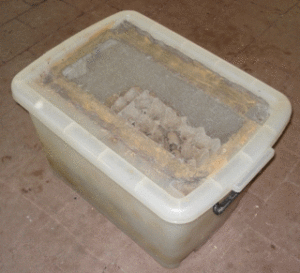Speckled Feeder Roaches
(Nauphoeta cinerea or Woodies)
Grow your own frog food!
 For many years we have bred both crickets and speckled feeder roaches for the green tree frogs and by far the easiest is the roach.
For many years we have bred both crickets and speckled feeder roaches for the green tree frogs and by far the easiest is the roach.
Why? Because Speckled Feeder Roaches are:
Easy to keep and breed. They live for about a year.
As they grow, they vary considerably in size – perfect to suit your frogs needs.
Equally as acceptable to amphibians as other foods. These roaches have a very high meat to shell ratio. The babies have a soft shell.
Unlike crickets, they almost ‘thrive on neglect. They don’t chirp like crickets. They don’t need as much room and you don’t have to keep so many tubs.
They are a reasonably large roach, growing to almost 30mm in length and have been used as a reptile/amphibian food item for several years.
Alternative common names include the Lobster Cockroach or Roach, Madeira, Cinereous, Tampa, Speckled and finally “Woodie”.
This species has a worldwide distribution and was originally named Blatta cinerea in 1789 from specimens taken in Mauritius and was not given its present name Nauphoeta cinerea until 1922.
It is a tropical domiciliary cockroach of the New and Old Worlds, occurring in Cuba, Hispaniola, Mexico, Brazil and the Galapagos Islands. In the East, it is widely distributed in the Phillippines, Sumatra and Singapore and occurs in Australia, New Caledonia and the Hawaiian Islands. The East African records extend from Egypt through the Sudan to eastern Tanganyika (now Tanzania), the Transvaal and Natal. It also occurs in Madagascar and Mauritius. Studies indicate that its native home is East Africa. Movement to other countries would have been no doubt by trading vessels and galleons as early as the sixteenth and seventeenth centuries. Colonies were identified in Florida, U.S.A in 1952 and were found established in an area of Tampa, Florida where there were mills producing animal feeds. Hence the common name Tampa Cockroach.
It was firsty recorded in Australia in 1918 where it is regarded as a ‘semi-domestic’ species, as it is found in out-houses and stores rather than in dwellings.
This is a false ovoviviparous species in which the oothecae (a cellular egg case) contain 26 – 40 eggs. The nymphs hatch as the female extrudes the ootheca from the brood sac; they shed their embryonic membrane as they hatch and eat both it and the ootheca. Newly hatched nymphs crawl beneath the female, even under her wings, and remain there for about an hour after hatching. In the laboratory the number of nymphs hatching from oothecae increases from an average of 20 from the first egg case to about 30 from the third and decreases thereafter. Female nymphs take longer to mature than males.
Biology of Nauphoeta cinerea based on Laboratory Data (Averages) at 30° C:
| Minimum period between molt to adult copulation | 6 days in both sexes |
| Interval between molt to adult and production of first ootheca | 13 days |
| Interval between moult to adult and hatch of first brood | 44 days |
| Interval between hatch of successive broods | 1st – 2nd, 40 days 7th – 8th, 99 days |
| Average broods per female | 6 |
| Incubation period in brood sac | 36 days |
| Eggs per ootheca | 33 |
| Hatched eggs per ootheca | 31 |
| Percentage of hatched insects that matured | 99% |
| Number of moults | 7 – 8 |
| Period of nymphal development in isolation: | |
| males (7 moults) | 73 days |
| females (8 moults) | 94 days |
| in groups: | |
| males | 72 days |
| females | 85 days |
| Adult Life Span: | |
| males | 365 days |
| females | 344 days |
With basic husbandry practices, ie. Proper holding containers, temperature, hygiene and food – your Speckled Feeder Roaches will thrive providing a very balanced food source for your green tree frogs at a more economical rate than most other alternatives. Don’t pay $6-7 or more per punnet two or three times a week at a pet store.
Disadvantages? Perhaps the main one is that they do climb up and out of plastic/glass containers if not prepared properly. This is discussed further below. A reminder that if these roaches do escape they will not take over your premises. Woodies or speckled feeder roaches will never infest your house and much prefer to live outdoors in bark or leaf cover. The lids should be well ventilated (not just a couple of holes drilled). Cut the majority of the centre part of the lid out leaving just the outer rim and at least a 50mm section all around to fix the mesh to. Purchase enough flywire mesh (the wire one – not the fibreglass one) to cover the cut out section with a bit of overhang. With a hot soldering iron, gently press the flywire into the plastic lid. Alternatively glue around the perimeter.

As mentioned, the roaches have the ability to climb up and over and out of plastic and glass containers. There are two methods of containing them. One method is to put a generous smear of vaseline around the top inner surface. This generally works but can become a bit messy. There are commercially available products but the odd escapee doesn’t usually warrant the expense.
To provide your roaches with a hiding area and also increasing the habitable living surface area, obtain some egg box trays, fruit divider trays, toilet rolls or opened egg cartons. Place plenty of these down one end of the holding container. If you are using the flat trays be careful to place them so they don’t collapse down on each other once stacked. Stack to about 5-10 cm below the lid.
There is no substrate required for the floor. This enables it to be cleaned easily.
Your container is now ready for habitation. All you need is a few from a breeder or pet shop to start.
The roaches do prefer to be kept at 25 – 30° C. This can be maintained by having them on a heat mat or flexible heating element. A probe thermostat or dimmer can control the temperature. The warmer they are, the more active they are.
You can feed the colony totally on carrots. Pellets can also be fed, dog & cat, and rabbit & guinea pig. Fresh carrot is important for moisture. No water is supplied. Provide enough carrot that your colony will devour in two days. Remove any uneaten carrot at this time or earlier if the carrot starts to decay. Other vegetables consumed include cauliflower, zuchini, apple, but don’t give onion, capsicum or citrus. Feeding your roaches a variety of foods will ulimately increase your frogs dietary intake. Gut load prior to feeding to your frogs helps.
To clean, shake insects from the cardboard hiding trays, tilt the holding container towards you, scrape any rubbish etc to the front of the box, return hiding material and roaches will go back under this. After a few minutes all that is left at the front end of the box is the rubbish which can then be removed. Easy really.
The roaches can be quite fast and hard to catch but cooling can control their speed. Naturally, when they are on a heat mat and kept at 30° C they are at their full potential, speed wise. Even by removing the container from the heat source and placing on the floor, particularly in the cooler months, is enough to slow them down to half speed. With a bit of practice and experimentation, you will find the method that suits you best. Try shaking some into a small container (with a lid with air holes) and place in the fridge for a few minutes.
If you require them to be slowed down, catch them first and place in a container that can be put in a cool place, try the fridge. How slow you want them to be can be worked out on the time you leave them in the fridge or the cool spot. Another way of slowing them down, whilst still offering ‘live’ food to your frogs is by decapitation. Simply, with a pair of scissors, cut off the heads before you offer them to your animals. They will still have movement for a short amount of time and this also eliminates the possibility of escapees or hiding from the predators. Alhough the roaches are about to become food for the frogs, I can’t decapitate. However, the info is supplied for your knowledge.
Removal from the holding container can be achieved in several ways and you may come up with some better methods. These are a few suggestions.
Remove them individually from the container with a pair of tweezers.
Keep toilet roll cardboard inners inside the container and when you require a number simply remove one of the inners that should have roaches inside.
Shake one or more of the cardboard dividers into a bucket that has vaseline around the inside top.
Put in a commercially available roach trap and catch some from the holding container.
Your green tree frogs wil appreciate fresh, fat, gut loaded roaches every time!
